Oversold Stock Market Expected to Bounce Higher Next Week
Stock-Markets / Stock Index Trading May 23, 2009 - 02:16 PM GMTBy: Mike_Burk
 The good news is: In spite of being down all of the last 4 days of last week, all of the major indices finished higher for the week.
The good news is: In spite of being down all of the last 4 days of last week, all of the major indices finished higher for the week.
Short Term: A reaction usually follows 4 consecutive days in either direction.
On Balance Volume (OBV) is calculated by adding the volume on up days and subtracting the volume on down days from a running total. OBV can be calculated on individual issues or the market as a whole. The idea is an issue or market is strong if volume is higher on up days than it is on down days or weak if the down days have higher volume than up days. Indicators often have biases and OBV calculated from NYSE data has a somewhat positive bias.
The first chart covers the last 3 months showing the S&P 500 in red and an indicator derived from NYSE OBV in black. The indicator shows the percentage of the last 3 trading days that NYSE OBV has been up. The indicator touches the top of the chart when NYSE OBV has been up for 3 consecutive days and it touches the bottom of the chart when NYSE OBV has been down for 3 consecutive days. NYSE OBV itself is not shown. Dashed vertical lines have been drawn on the 1st trading day of each month.
The indicator has hit the bottom of the chart in each of the last 2 weeks for the 1st time since the early March lows.
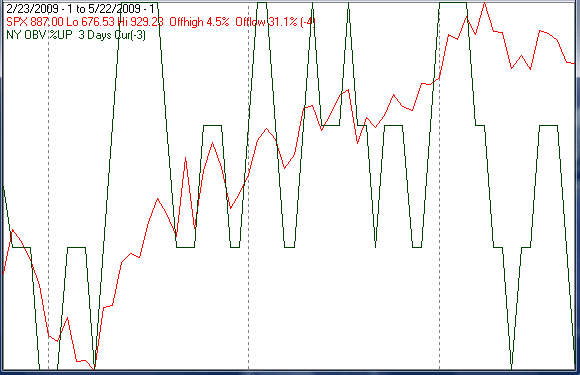
The next chart is similar to the previous one except it covers the last year to give you a broader perspective.
Its positive bias makes the indicator quick to indicate up moves with a lot of false signals. Its record for indicating the beginning of downside moves is a lot better, especially when it hits the bottom of the chart more than once in a relatively short period like we have just seen.
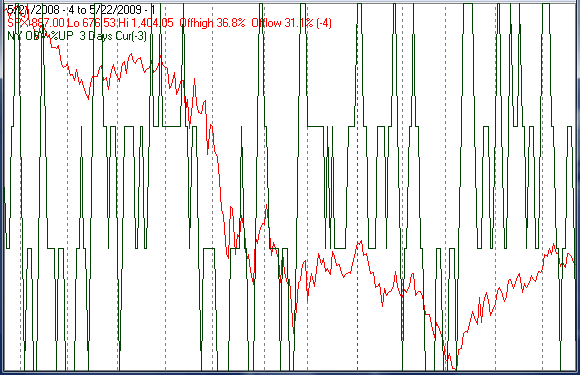
It also indicates a short term oversold condition and a high likelihood of a bounce in the next few days.
Intermediate term
On March 6 there were 827 new lows on the NYSE and 567 on the NASDAQ. Those numbers are big enough to suggest a high likelihood of a retest of the March 9 lows.
A ratio of new highs to new lows (NH / (NH + NL) is one of the best indicators we have for defining both tops and bottoms and the general health of the market.
I have been showing updates of the chart below for the last several weeks. It covers the past 6 months showing the NASDAQ composite (OTC) in blue and a 40% trend (4 day EMA) of NASDAQ new highs / (new highs + new lows) in red. Dashed vertical lines have been drawn on the 1st trading day of each month and dashed horizontal lines have been drawn at 10% levels of the indicator. The horizontal line is solid at the 50% level.
Considering the OTC was down the last 3 days of the week, the indicator held up very well.
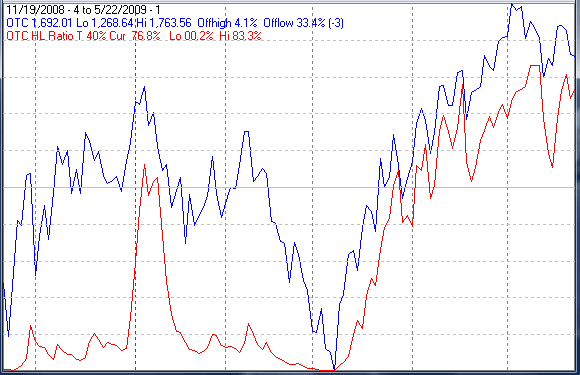
The next chart is similar to the one above except it shows the SPX in red and the indicator calculated from NYSE data in dark blue.
The indicator calculated from NYSE data also recovered nicely last week.
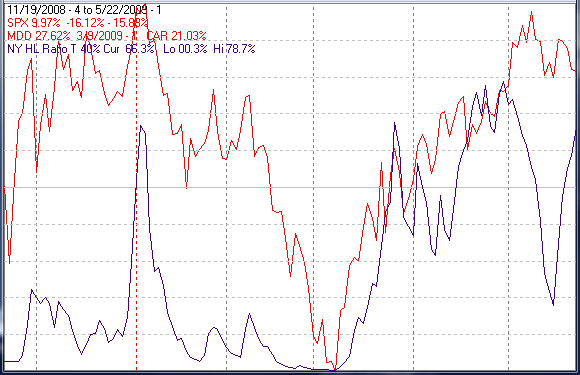
Seasonality
Next week includes the last 4 trading days in May during the 1st year of the Presidential Cycle.
The tables show the daily return on a percentage basis for the last 4 trading days of May during the 1st year of the Presidential Cycle. OTC data covers the period from 1963 - 2008 and SPX data from 1928 - 2008. There are summaries for both the 1st year of the Presidential Cycle and all years combined.
The week has, on average, shown modest losses during the 1st year of the Presidential Cycle and modest gains over all years.
Report for the last 4 days of May.
The number following the year represents its position in the presidential cycle.
The number following the daily return represents the day of the week;
1 = Monday, 2 = Tuesday etc.
| OTC Presidential Year 1 | |||||
| Day4 | Day3 | Day2 | Day1 | Totals | |
| 1965-1 | -0.73% 2 | 0.60% 3 | -0.83% 4 | -0.36% 5 | -1.32% |
| 1969-1 | -0.13% 1 | -0.09% 2 | -0.75% 3 | -0.27% 4 | -1.24% |
| 1973-1 | 0.86% 5 | -0.30% 2 | -1.58% 3 | -0.53% 4 | -1.56% |
| 1977-1 | -0.50% 3 | -0.01% 4 | -0.28% 5 | -0.32% 2 | -1.11% |
| 1981-1 | 0.46% 2 | 0.88% 3 | 0.51% 4 | 0.07% 5 | 1.92% |
| 1985-1 | -0.43% 2 | -0.08% 3 | -0.24% 4 | 0.30% 5 | -0.46% |
| Avg | 0.05% | 0.08% | -0.47% | -0.15% | -0.49% |
| 1989-1 | 0.32% 4 | 0.52% 5 | -0.22% 2 | 0.44% 3 | 1.06% |
| 1993-1 | 0.05% 2 | 1.30% 3 | 0.07% 4 | -0.58% 5 | 0.85% |
| 1997-1 | 1.40% 2 | 0.07% 3 | -0.51% 4 | -0.19% 5 | 0.77% |
| 2001-1 | -1.36% 5 | -3.35% 2 | -4.18% 3 | 1.25% 4 | -7.65% |
| 2005-1 | -0.56% 3 | 1.03% 4 | 0.22% 5 | -0.36% 2 | 0.33% |
| Avg | -0.03% | -0.09% | -0.93% | 0.11% | -0.93% |
| OTC summary for Presidential Year 1 1965 - 2005 | |||||
| Averages | -0.06% | 0.05% | -0.71% | -0.05% | -0.76% |
| % Winners | 45% | 55% | 27% | 36% | 45% |
| MDD 5/30/2001 8.65% -- 5/31/1973 2.41% -- 5/28/1965 1.32% | |||||
| OTC summary for all years 1963 - 2008 | |||||
| Averages | -0.01% | 0.05% | 0.17% | 0.27% | 0.49% |
| % Winners | 52% | 63% | 57% | 72% | 61% |
| MDD 5/30/2001 8.65% -- 5/27/1970 3.17% -- 5/25/1999 2.97% | |||||
| SPX Presidential Year 1 | |||||
| Day4 | Day3 | Day2 | Day1 | Totals | |
| 1929-1 | -3.32% 1 | 1.61% 2 | 0.12% 3 | 0.85% 5 | -0.73% |
| 1933-1 | 2.86% 5 | 3.21% 6 | 1.45% 1 | -1.43% 3 | 6.10% |
| 1937-1 | -1.28% 2 | -0.12% 3 | 0.18% 4 | 0.00% 5 | -1.21% |
| 1941-1 | 0.64% 2 | 0.00% 3 | -0.11% 4 | -0.32% 6 | 0.22% |
| 1945-1 | 0.54% 6 | 1.08% 1 | 0.53% 2 | -0.66% 4 | 1.49% |
| Avg | -0.11% | 1.16% | 0.44% | -0.31% | 1.17% |
| 1949-1 | 0.48% 3 | -0.07% 4 | -0.34% 5 | -2.21% 2 | -2.13% |
| 1953-1 | -0.48% 2 | -0.92% 3 | -0.73% 4 | 0.33% 5 | -1.81% |
| 1957-1 | -0.91% 1 | -0.19% 2 | 0.90% 3 | 0.68% 5 | 0.48% |
| 1961-1 | -0.63% 3 | -0.38% 4 | 0.64% 5 | 0.20% 3 | -0.18% |
| 1965-1 | 0.58% 2 | -0.34% 3 | -0.52% 4 | 0.66% 5 | 0.38% |
| Avg | -0.19% | -0.38% | -0.01% | -0.07% | -0.65% |
| 1969-1 | -0.22% 1 | -0.76% 2 | -0.30% 3 | 0.19% 4 | -1.08% |
| 1973-1 | 0.75% 5 | -0.40% 2 | -1.49% 3 | -0.91% 4 | -2.05% |
| 1977-1 | -0.92% 3 | 0.25% 4 | -0.76% 5 | -0.16% 2 | -1.59% |
| 1981-1 | 1.10% 2 | 0.75% 3 | -0.24% 4 | -0.64% 5 | 0.97% |
| 1985-1 | -0.23% 2 | -0.10% 3 | 0.04% 4 | 0.96% 5 | 0.67% |
| Avg | 0.09% | -0.05% | -0.55% | -0.11% | -0.62% |
| 1989-1 | 0.01% 4 | 0.76% 5 | -0.79% 2 | 0.46% 3 | 0.44% |
| 1993-1 | 0.19% 2 | 1.02% 3 | -0.23% 4 | -0.49% 5 | 0.49% |
| 1997-1 | 0.32% 2 | -0.29% 3 | -0.37% 4 | 0.50% 5 | 0.15% |
| 2001-1 | -1.18% 5 | -0.78% 2 | -1.57% 3 | 0.62% 4 | -2.91% |
| 2005-1 | -0.34% 3 | 0.64% 4 | 0.10% 5 | -0.61% 2 | -0.21% |
| Avg | -0.20% | 0.27% | -0.57% | 0.10% | -0.41% |
| SPX summary for Presidential Year 1 1929 - 2005 | |||||
| Averages | -0.10% | 0.25% | -0.17% | -0.10% | -0.13% |
| % Winners | 50% | 40% | 40% | 50% | 50% |
| MDD 5/30/2001 3.49% -- 5/27/1929 3.32% -- 5/31/1973 2.77% | |||||
| SPX summary for all years 1928 - 2008 | |||||
| Averages | 0.06% | -0.03% | 0.18% | 0.04% | 0.25% |
| % Winners | 56% | 49% | 60% | 59% | 62% |
| MDD 5/31/1932 12.52% -- 5/28/1962 8.45% -- 5/31/1935 4.49% | |||||
Money supply (M2)
The chart below was provided by Gordon Harms. Money supply growth has continued to fall.
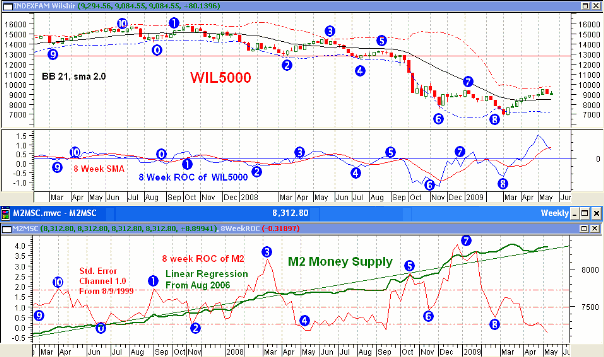
Conclusion
Based on the number of consecutive down days, the market is oversold and likely to bounce. In the next week or two the blue chip indices could hit new highs which would likely be the top for this cycle.
I expect the major indices to be higher on Friday May 29 than they were on Friday May 22.
Last weeks negative forecast was a miss.
Thank you,
By Mike Burk
To subscribe to this report : http://alphaim.net/signup.html
Gordon Harms produces a Power Point for our local timing group. You can get a copy of that at: http://www.stockmarket-ta.com/ .
Disclaimer: Mike Burk is an employee and principal of Alpha Investment Management (Alpha) a registered investment advisor. Charts and figures presented herein are believed to be reliable but we cannot attest to their accuracy. Recent (last 10-15 yrs.) data has been supplied by CSI (csidata.com), FastTrack (fasttrack.net), Quotes Plus (qp2.com) and the Wall Street Journal (wsj.com). Historical data is from Barron's and ISI price books. The views expressed are provided for information purposes only and should not be construed in any way as investment advice. Furthermore, the opinions expressed may change without notice.
Mike Burk Archive |
© 2005-2022 http://www.MarketOracle.co.uk - The Market Oracle is a FREE Daily Financial Markets Analysis & Forecasting online publication.



